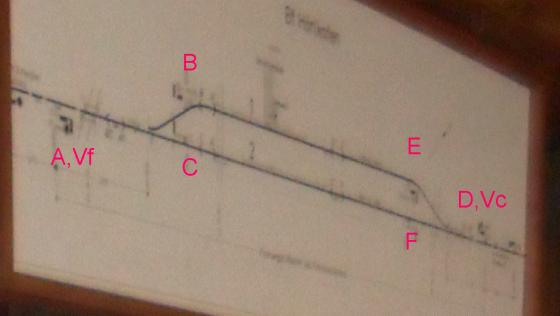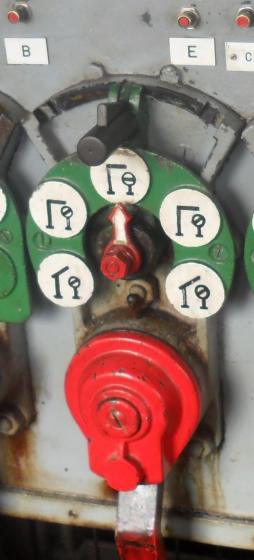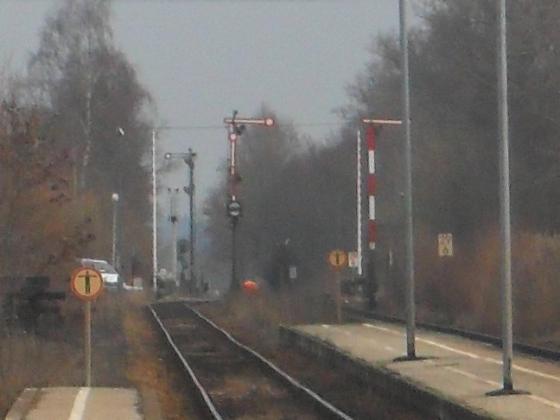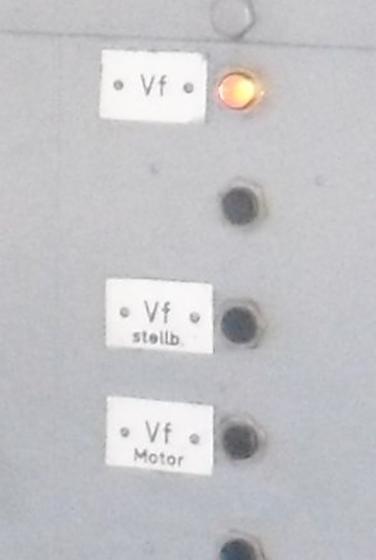
Some time ago, I have described the Krauss lever frame at Hörlkofen. On that line from Markt Schwaben to Mühldorf in Bavaria, there are currently two more Krauss frames originating from the 19th century, namely at Schwindegg and at Weidenbach.
Here is a series of photos of the Schwindegg frame. In contrast to Hörlkofen (and Weidenbach), Schwindegg has an additional loading track—sort of: The track itself is interrupted and paved over at one place, but it is still fully integrated into the interlocking logic. On the following pictures, one can see, with some reflections, the track plan of Schwindegg:
Here is the complete interlocking:
In contrast to Hörlkofen, the Siemens block instruments are in the same room with the lever frame. And, also in contrast to Hörlkofen, there is no "normal position" for the direction of the block instrument—which is actually the rule. Hörlkofen - Markt Schwaben, for some reason, does have a normal position for the direction, apparently because of the S-Bahn traffic from Munich to Markt Schwaben (to Erding). I hope to understand the details of that somewhen ...
Let's return to Schwindegg. On the frame, there are five cranks for
- the home signal D on the Weidenbach side
- the two-arm semaphore starting signals on track 1 (E to Weidenbach, B and shunting signal Hs I on the Dorfen side)
- distant signal Vc for starting signal C at home signal D
- the single-arm semaphor starting signals on Gleis 2 (F to Weidenbach, C to Dorfen - no shunting signal here!)
- home signal A from Dorfen
- the distant signal Vf for starting signal F at home signal A
- points and FPL levers for points no.9
- derail for the loading track
On the right side of the lever frame, we finally have
- the lever for shunting signal Hs 2
- points and FPL levers for points no.1
By rule, the route levers must carry clear indications which levers (of points, FPLs, derails, and shunting signals) must be in which position so that the route can be locked. Here are these indications for the two rightmost cranks:
But why are these signs so different? Blame the German "EBA" ("Eisenbahnbundesamt": The authority overlooking all railways): Some time ago, this station, as well as a few others on this line, got an inspection visit. During this visit, manual corrections and some missing inscriptions were criticised. Therefore, new signs were ordered (it seems they are produced by a shop employing handicapped), and someone decided that the new signs should carry that beautiful old Gothic print! However, the sign for track 2 had some error on it, so a new one needs to be made—but then, all signs will "look like old"!
At the same time, also the symbols at the cranks were corrected—that's what they now look like:
Some of the stations masters think this looks more like kindergarten ... Also, historically, the signs are not that correct: On the one hand, they show the old Bavarian style arms ending with a square; and also they show one-arm also for track 1, even though these signals are actually two-arm semaphores with coupled arms:
On the other hand, the shunting signal Hs I is correctly, but non-Bavarian, shown as a separate signal ... oh well, if the EBA is happy with it, why shouldn't I be?
There are block locks ("Tastensperren") above the start and end blocks ("Anfangsfeld", "Endfeld"). A train director (see my dictionary for this term) explained to me that the blocks also, electrically, lock the corresponding route levers: The route lever can be returned to normal only after the block lock has returned from blue to white by the train:
The distant signals of the home signals are cleared by electric motors. The control lamps for them are above the signal cranks:
At last, here is a picture of the electric lever locks. Actually, the lock the catch handles on the levers. The catch can be lifted if the small window shows white:
The lever lock at the lever for distant signal Vf is activated directly by the catch handle. For the points levers, it is necessary to push a separate long key which can be seen at the upper left:
The following pictures shows the cranks, then the angle levers for moving the route bars, and then the wires to the signals:
Finally, here are a few pictures from the station:
On the Mühldorf side, the shunting signals were removed some time ago. It seems nobody wanted to take them, and the EBA did not protest this small junkyard:
Here is a picture of the brutally cut loading track:
Finally, this picture of the station shows the signal box annex on the right:































